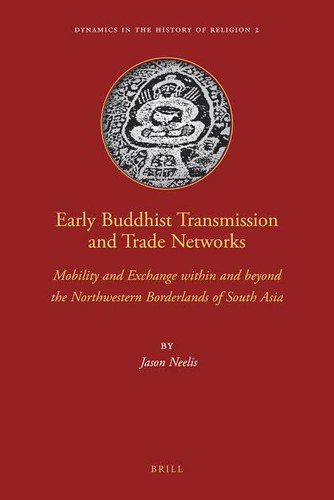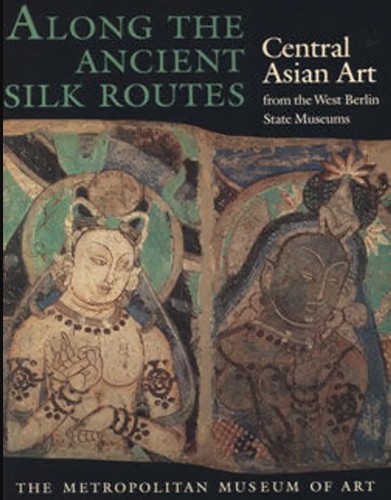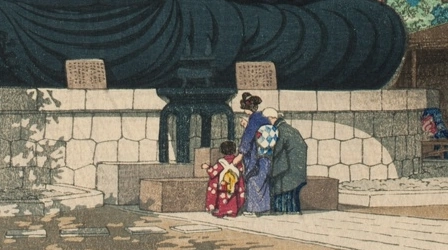Medieval Buddhism
Subscribe to this topic via: RSS
This bibliography explores how Buddhism spread along the Silk Roads out of India and across Asia in particular asking what traders and local rulers got out of adopting Buddhism and how Buddhism changed as it made contact with other cultures. “Medieval” is used here very loosely to mean “pre-modern Buddhism outside India.” This tag therefore starts with the Ashokan missions and goes all the way to Europe’s contact with Asia in the Modern period.

A pilgrim is shown carving Buddha statues to pay for his iterant lifestyle, symbolized by wild ducks, in this woodcut illustration from 1870 by Kawanabe Kyōsai.
Table of Contents
Books (9)
Featured:
See also:
Canonical Works (1)
-
⭐ Recommended
In this desert, there are no fruits, roots or any food or drink. There is no way to make a fire. There is only dust and scorching sand.
Readings (59)
Featured:
-
🥇 Best of
The relationship between Buddhism and society was apparent in nearly every aspect of medieval life…
33 pages -
⭐ Recommended
Virtuosity in chanting spells and working miracles—particularly those associated with healing, protection, and other aspects of personal welfare—was an important quality for a monk to develop.
-
⭐ Recommended
Buddhist literature offers us the only narratives from this period that feature to any great extent the nautical or maritime traveller as hero.
-
⭐ Recommended
Whereas the texts discussed in the first section generally argue for a stricter separation between these two domains, those in the second [Mahāyāna wave] strove to integrate medicine into the very heart of Buddhism.
-
⭐ Recommended
Among the Dunhuang documents, when examining some of the monk signature lists, name list of monks copying scriptures and name list of monks chanting scriptures in monasteries, we can estimate a relatively accurate literacy rate of the Buddhist sangha. Generally speaking, the literacy rate of the sangha during the Guiyi Army 歸義軍 period (851–1036) was lower than that during the Tibetan occupation period (786–851). The reason for this change is closely related to each regime’s Buddhist policy, the size and living situation of the sangha, and the Buddhist atmosphere.
-
⭐ Recommended
To see the image strictly as something to be seen is, in Skilling’s Buddhologist eyes, nothing less than to manifest ignorance…
-
⭐ Recommended
As a sacred site for pilgrimage, Bodhgayā became even more prominent from the sixth and seventh centuries onward, when the rebuilding of the Mahābodhi Temple coincided with the installation of a Buddha statue with the earth-touching gesture, symbolic of the Buddha’s calling upon the earth to bear witness to his victory over evil. Miracles enshroud the creation of the image itself, and later it became a famous icon widely copied throughout the Buddhist world.
-
… this paper explores the processes by which he was transformed into a saintly figure. The manifold images of Xuanzang reflected the interaction and synthesis of Chinese and Indian Buddhist traditions that began during the early medieval period, further transformations when transmitted to other cultures, distinctions between elite and popular worship, and the intertwining of visualal and literary forms of [Buddhist] art.
-
I would like to consider the blend of Indian and Chinese cultures that is evident in the works of Indian scholar monks who immigrated to China.
-
Even the sundry demons of hell broke off their cruel horns. Indeed, it seemed as if all the beings from the eight great hells up to the one-hundred thirty-six minor hells might gain liberation.
-
I find it reasonable that a period that was characterized by both a low standard in Pāli and indeed Buddhist learning, and a desire to effect a revival of Buddhist thought and practice could provide a fertile context for the acceptance of a work like the Tuṇḍilovāda Sutta. As happened with “apocryphal” Buddhist literature in other contexts, “suspicions concerning the authenticity of a text (may have) paled as its value in explicating Buddhist doctrine and practice became recognized.”
-
One of the early functions of the talisman was for a ruler to authorize the conduct and scope of authority of a general (e.g., how many troops he could command). The military context of talismans later found a corollary in the spiritual realm and permitted their possessor to summon and control a variety of deities that could be drawn on in battles with spirits.
-
This article discusses the history of talismans in Central Asian Buddhism and their origin in East Asia, particularly through Daoism. For the Uyghurs, a Turkic people who converted to Buddhism in Central Asia, talismans were linked to esoteric Buddhism, as shown through texts found in the Dunhuang. The article ends with a look at talismans in Old Uyghur texts.
-
Missionary monks encountered these zones of multicultural influences, either in situ or in the diasporas of the great cities of North India or China, many of them became enamored of the paradoxical presence of metropolitan sophistication and rural isolation that Central Asia afforded
-
The Kumano shrines were among the most popular pilgrimage sites of medieval Japan, drawing devotees across geographic, sectarian, class, and gender barriers. Yet this pilgrimage, which is often seen as a paradigmatic and formative example of Japanese popular religion, was instituted by the country’s ruling elite as an elaborate ritual of state.
-
Actually, during the Song, although marginal, this dual acceptation of supernaturalism and its antithesis manifests itself not only in Chan biographies, but also in doctrinal writings of the school.
-
This paper takes a closer look at the variations in the translation of tridoṣa in Chinese. I argue that translation inconsistencies reflect not confusion, but a range of strategic translation decisions. While some translators prioritised closer fidelity to Sanskrit originals, most chose to emphasise the compatibility between Indian and Chinese medical thought by glossing the tridoṣa with terms that were loaded with indigenous metaphorical connotations. In a rereading of one such passage, I show that understanding so-called errors as translation tactics allows historical analysis to move beyond a limited focus on the accuracy of translations and to instead explore the cultural resonances and social logics of translated texts in their historical context.
-
Aśoka (c. 268-232 BCE) and Jayavarman VII (1182-1220?), two of the greatest rulers of India and Southeast Asia, were Buddhists by any definition. However, the puzzling problem is that their deaths were followed by an inexorable decay of their erstwhile great empires.
19 pages -
… we might regard Big Hand as a student, perhaps a young monk struggling to become fluent
-
The first part, as is usual in votive texts, opens up a wide perspective on the Buddhist teaching and the value of sutras. It evokes the ephemeral nature of the world, including our fragile human existence. Rescue can only come through the knowledge of the correct texts that save and protect.
-
The historical period of this area was the third century until 627–649, when Zhenla took over. Buddhism on this route was mahāsāmghika. Important was Avalokiteśvara, Nanhai Guanyin, who may have merged with Mazu along the southern Chinese coast.
-
This article looks at how Buddhism affects businesses started by Buddhists. The researchers believe Buddhist ideas can help these businesses succeed, partly by encouraging the owners to take risks. They studied over 1,000 businesses in China and found evidence to support their ideas.
-
The vinaya canon, some major sutras and the writings of eminent vinaya exegete Daoxuan in China insisted that astrology was not to be practiced by a Buddhist monk or nun. Despite this fact, a tradition of Buddhist astrology nevertheless emerged in China from the eighth century and came to full maturity in the ninth century.
15 pages -
I present here a preliminary report on selected engraved or inscribed objects, most of them recently found in Southeast Asia. Foremost among them are those indited with the single word apramāda: ‘careful’, ‘heedful’, ‘aware’.
-
Although the sūtra allows for war, it does so only under special conditions and with special restrictions on its conduct. In a graded series of skillful means, a king must first try to befriend, then to help, and then to intimidate his potential enemy before resorting to war.
-
In 1240, Köten famously summoned the Central Tibetan Buddhist polymath Sakya Pandita, by then already an old man, to his court at Liangzhou. Examining Tibetan and Mongolian accounts about their meeting from the last seven centuries, this study shows that it was neither compelling philosophy nor some turn of faith that converted the Mongols. It was, rather, Sakya Pandita’s violent therapeutic intervention into the space of Köten’s ill body that wrenched the Mongol body politic into the Dharmic fold.
-
… scholarship has always interpreted the resurgence of Buddhist activity at Ajanta and neighboring sites as a regional phenomenon linked to the prestige of a dominating group and to internal political strives. Yet at a closer look, it appears that much like in earlier times, the life of these rock-cut sites in the fifth century continued to be closely related to a network of commercial activities
-
This paper attempts to describe the many difficulties faced by the first Buddhist translators through the analysis of the translation of a particular poem, the Buddhacarita. The case study aims at pointing out how this translation process involved linguistic, religious and cultural issues.
-
In Buddhist materials translated into Chinese, from the earliest times onwards, local magistrates are viewed in an extremely negative light. They are indeed most frequently grouped with bandits as a potential threat to property or worse…
-
… while Indians like Mahinda, Buddhaghosa, Dhammapala and Ramachandra Bharati, were able to have a profound influence on Sri Lankan Buddhism, Sri Lankans were able to have equally profound effects on Indian Buddhism
-
The Taliban were by no means the first people to try to destroy the Buddhas. Islamic iconoclasts had been hacking away at them for centuries. The Emperor Aurangzeb ordered cannons to blast the statues, as did a Persian king in the 18th century. Both attempts damaged but did not destroy the statues.
See also:
Audio/Video (11)
Featured:
-
 1h 28 m
1h 28 m -
How the figure of the Bodhisattva and of the Wheel-Turning Monarch merged for political advantage when Buddhism left India.
48 min -
How Southeast Asia didn’t just passively absorb Indian religions, but actively transformed them.
45 min -
Besides silk, the Silk Road helped the dispersion of writing and paper-making, coinage and gunpowder, and it was along these trade routes that Buddhism reached China from India. The history of these transcontinental links reveals a dazzlingly complex meeting and mingling of civilisations, which lasted for well over a thousand years.
45 min -
 5 min
5 min
See also:


